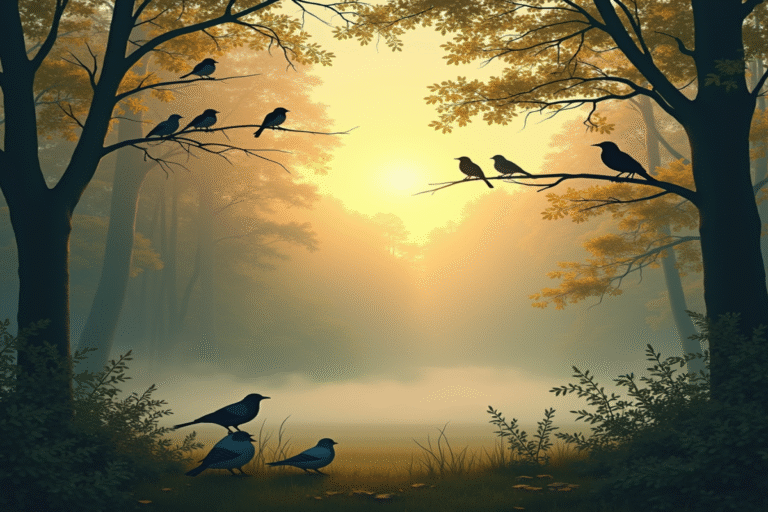Have you ever been awakened by a symphony of bird songs just as the first light of dawn breaks across the sky? This natural phenomenon—the dawn chorus—is one of nature’s most spectacular daily events, yet many of us rarely stop to ask why birds collectively decide that the crack of dawn is the perfect time for a musical performance.
The Magical Symphony of Dawn
Each morning, typically starting about 30–90 minutes before sunrise, birds begin their songs in a specific order. First come the early risers like robins and blackbirds, followed by wrens, warblers, and finally the late singers like pigeons and doves. This sequential performance creates a layered orchestra that gradually builds as light increases—a phenomenon observed on every continent except Antarctica.
Scientific Explanations: Why Dawn?
Perfect Acoustic Conditions
Dawn offers ideal conditions for sound transmission. The air is usually still, with minimal wind or thermal turbulence that might distort sound waves. Scientists have found that bird songs can travel much farther at dawn than at midday. The cooler air often causes a “temperature inversion,” where sounds bend back toward the ground rather than dissipating upward—giving birds a natural amplification system.
Energy Economics: The Morning Advantage
After a night’s rest, birds have recovered their energy reserves but haven’t yet begun the demanding tasks of finding food. Studies show that a bird’s testosterone levels are highest in the early morning, providing the perfect physiological state for energetic singing. Singing before the day’s activities is an efficient use of resources.
The Honesty Principle
Perhaps the most fascinating theory involves what biologists call “honest signaling.” A male bird singing vigorously at dawn is sending a clear message: “I’m so fit and healthy that I survived the night and still have enough energy to sing powerfully.” This show of strength is especially impressive after cold nights when energy reserves are tested, making dawn singing a reliable signal of a bird’s genetic quality to potential mates.
Surprising Facts About the Dawn Chorus
Did you know that birds have accents? Just like human regional dialects, bird songs can vary geographically within the same species. Some birds, such as mockingbirds and starlings, are “open-ended learners” that continue to add new sounds to their repertoire throughout their lives, sometimes copying environmental sounds like car alarms or phone ringtones.
While we often associate singing with joy, for birds it is serious business. Males who sing more complex songs and have larger repertoires typically attract more mates and defend territories more successfully. Some songbirds, including the sedge warbler, can sing continuously for hours without repeating the same phrase twice—a vocal feat that would challenge even the best human singers.
A Delicate Relationship with Humans
The dawn chorus is a sensitive indicator of ecosystem health. Studies have shown that urban birds now sing at higher pitches to rise above city noise, and some species have shifted their dawn chorus to begin earlier in areas with significant light pollution. This adaptability shows both their resilience and vulnerability to human influence.
Climate change is also changing the timing and composition of the dawn chorus. As spring temperatures arrive earlier, birds begin their breeding seasons—and their morning songs—sooner than in past decades. Scientists now use recordings of dawn choruses from decades ago to track these changes and understand their ecological impacts.
The Orchestra Members
Different species contribute unique “instruments” to the dawn orchestra:
- American Robin: Often the first to sing, with a cheerful, fluid warble
- Eastern Whip-poor-will: Adds a haunting, repetitive call that can last for hours
- Song Thrush: Performs one of the most complex songs, often repeating phrases several times
- Nightingale: Famous for its elaborate performances with over 200 different song types
Experiencing This Natural Wonder
The most dramatic dawn choruses occur during spring breeding season, especially in May in the Northern Hemisphere, when competition for mates and territory peaks. To experience this phenomenon, find a quiet place away from urban noise, arrive about an hour before sunrise, and simply listen as the world awakens.
Some dedicated nature lovers take part in International Dawn Chorus Day (the first Sunday in May), when people worldwide wake up early to enjoy and sometimes record this natural symphony—a reminder that we share our world with millions of other species, each with their own complex behaviors and communication systems that we are only beginning to understand.
The next time you hear the dawn chorus, remember you are witnessing an ancient ritual—a complex interplay of evolution, physics, and animal behavior developed over millions of years. In our increasingly human-dominated world, these morning melodies remind us of nature’s intricate and enduring rhythms.





